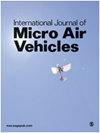基于地平检测的热图像姿态估计
IF 1.6
4区 工程技术
Q2 ENGINEERING, AEROSPACE
引用次数: 9
摘要
在许多低成本无人机中,缺乏冗余的姿态传感器是一个相当普遍的弱点。除了使用姿态传感器外,利用地平线作为姿态控制的视觉参考也是人类飞行员训练的一部分。因此,鉴于图像传感器的理想特性,已经进行了大量研究,提出使用视觉传感器进行地平线检测,以获得无人机上的冗余姿态估计。然而,大气和照明条件可能会阻碍可见光图像传感器的可操作性,甚至使其使用不切实际,例如在夜间。热红外图像传感器具有更广泛的操作条件,其价格在过去几年中大幅下降,在某些操作场景中成为可见光谱传感器的替代品。本文提出了两种姿态估计方法。第一种方法包括一种新的方法来估计最适合热图像中地平线的线。然后,使用无限地平线模型,使用所得线来估计俯仰角和滚转角。第二种方法使用深度学习,使用热图像的原始像素强度来预测姿态角。为此,使用惯性导航系统的测量值训练了一种新的卷积神经网络结构。所提出的两种方法都被证明适用于冗余姿态估计,均方根误差低于1.7°,运行频率高达48 Hz,具体取决于所选方法、输入图像分辨率和可用的计算能力。本文章由计算机程序翻译,如有差异,请以英文原文为准。
Attitude estimation using horizon detection in thermal images
The lack of redundant attitude sensors represents a considerable yet common vulnerability in many low-cost unmanned aerial vehicles. In addition to the use of attitude sensors, exploiting the horizon as a visual reference for attitude control is part of human pilots’ training. For this reason, and given the desirable properties of image sensors, quite a lot of research has been conducted proposing the use of vision sensors for horizon detection in order to obtain redundant attitude estimation onboard unmanned aerial vehicles. However, atmospheric and illumination conditions may hinder the operability of visible light image sensors, or even make their use impractical, such as during the night. Thermal infrared image sensors have a much wider range of operation conditions and their price has greatly decreased during the last years, becoming an alternative to visible spectrum sensors in certain operation scenarios. In this paper, two attitude estimation methods are proposed. The first method consists of a novel approach to estimate the line that best fits the horizon in a thermal image. The resulting line is then used to estimate the pitch and roll angles using an infinite horizon line model. The second method uses deep learning to predict attitude angles using raw pixel intensities from a thermal image. For this, a novel Convolutional Neural Network architecture has been trained using measurements from an inertial navigation system. Both methods presented are proven to be valid for redundant attitude estimation, providing RMS errors below 1.7° and running at up to 48 Hz, depending on the chosen method, the input image resolution and the available computational capabilities.
求助全文
通过发布文献求助,成功后即可免费获取论文全文。
去求助
来源期刊

International Journal of Micro Air Vehicles
ENGINEERING, AEROSPACE-
CiteScore
3.00
自引率
7.10%
发文量
13
审稿时长
>12 weeks
期刊介绍:
The role of the International Journal of Micro Air Vehicles is to provide the scientific and engineering community with a peer-reviewed open access journal dedicated to publishing high-quality technical articles summarizing both fundamental and applied research in the area of micro air vehicles.
 求助内容:
求助内容: 应助结果提醒方式:
应助结果提醒方式:


